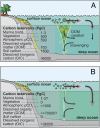Evolution of the ocean's "biological pump"
- PMID: 21949394
- PMCID: PMC3189068
- DOI: 10.1073/pnas.1112236108
Evolution of the ocean's "biological pump"
Conflict of interest statement
The author declares no conflict of interest.
Figures

Comment on
-
Biologically induced initiation of Neoproterozoic snowball-Earth events.Proc Natl Acad Sci U S A. 2011 Sep 13;108(37):15091-6. doi: 10.1073/pnas.1016361108. Epub 2011 Aug 8. Proc Natl Acad Sci U S A. 2011. PMID: 21825156 Free PMC article.
References
-
- Kump LR, Bralower TJ, Ridgwell A. Ocean acidification in deep time. Oceanography. 2009;22:94–107.
-
- Fairchild IJ, Kennedy MJ. Neoproterozoic glaciation in the earth system. Geol Soc London J. 2007;164:895–921.
-
- Hoffman PF, Kaufman AJ, Halverson GP, Schrag DP. A neoproterozoic snowball earth. Science. 1998;281:1342–1346. - PubMed
-
- Peltier WR, Liu Y, Crowley JW. Snowball Earth prevention by dissolved organic carbon remineralization. Nature. 2007;450:813–818. - PubMed
Publication types
MeSH terms
LinkOut - more resources
Full Text Sources

